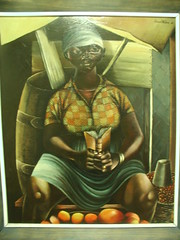
"The Laud is My Shepherd," Osmond Watson
Originally uploaded by Edu-Tourist.
This is one of the fascinating works of art on display at the National Gallery of Jamaica.
Experiments in travel, geography, and urban studies

This is one of the fascinating works of art on display at the National Gallery of Jamaica.




Additional News Sites:
The shaded pool of water at the base of the falls was a refreshingly cool reward for our efforts.With some scrambling I found it possible to perch on a high rock shelf behind the falls. Several of the students also engaged in cliff jumping, although the pool itself was only perhaps six feet deep. Walking back up the steps, I noticed several local youths outlined in profile under one of the arched passages smoking ganga from a water pipe.
http://www.schoolnet.na | Comments
I'm in Berlin, speaking at Wizards of OS tomorrow, and hanging out with some of my Open Society Institute friends. So far, the conference is a little ideological for my tastes, unreformed capitalist that I am, but the company is pretty good.I had the great pleasure of having dinner last night with Joris Komen of SchoolNet Namibia, one of my favorite projects on the African continent. Joris and crew have been bringing low-cost harware, Unix software and training into schools throughout Namibia - at present, they've worked with close to 250 schools throughout the country.
The major achievement of SchoolNet, from my perspective, is the substantial concessions they've gotten from the Namibian government. They've gotten the state telco to provision service to schools at extremely low cost, which allows them - with some grant funding - to give funding to schools at no cost. And they've gotten access to the 2.6Ghz frequency, which they're using to provide wireless access to rural schools across the nation, a crucial strategy in a nation as huge and sparsely populated as Namibia.
Joris observed that educational uses are a great lever for telecommunications reform in African countries. Most arguments about telco reform in Africa end up in battles between incumbent telco providers trying to protect a near-monopoly on service versus new players who attack that monopoly with new tech. Joris suggests changing the debate, by forcing dominant telcos either to prove that they can provide universal service to schools ... or get out of the way and allow new technologies and new companies to do it. A very cool strategy, and a good proof of concept in the successes SchoolNet have achieved so far.
Geeking in the Third World by Richard Koman -- Geekcorps volunteers work in third world countries helping companies become technically competent IT businesses. Richard Koman interviews Geekcorps founder Ethan Zuckerman.
Two years ago, Hossein Derakhshan (better known as "Hoder") posted a Web page with instructions on blogging in Farsi called "How to build a Persian weblog.” NITLE now reports 62,901 Farsi weblogs, making Farsi the third most popular weblog language. As the Iranian blogger community grew, Hoder and others, including Pedram Moallemian of The Eyeranian began blogging in Farsi and English, and encouraging others to do likewise, so that non -Farsi speakers could understand the current political and cultural situation in Iran. Sites like IranFilter now allow English speakers to understand the concerns of an Iranian community that's reaching out to the wider world.
BlogAfrica is one of several projects underway designed to build bridges between bloggers in Africa and the rest of the world. The BlogAfrica site hosts a catalog of blogs written by Africans or Afrophiles and aggregates these blogs into an African blog RSS feed. Working with volunteers working in Africa with Peace Corps or Geekcorps and visitors traveling to Africa, BlogAfrica is running public workshops in Internet cafes and universities to introduce weblogging to a new population. In future trips, BlogAfrica plans to bring prominent webloggers to Africa to teach workshops, encourage local bloggers and share their perceptions of Africa with their blog readers. Early participants in the workshops include Adam Chambas, whose Accra Crisis blog provides a first-person view of the 2004 Ghanaian presidential campaign.